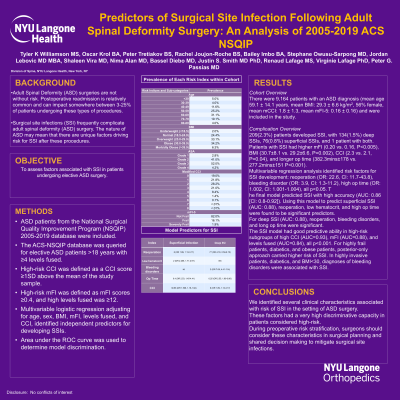Predictors of Surgical Site Infection Following Adult Spinal Deformity Surgery: An Analysis of 2005-2019 ACS NSQIP
Friday, April 21, 2023


Peter G. Passias, MD
Spine Surgeon
NYU School of Medicine
New Canaan, CT, US
ePoster Presenter(s)
Introduction: Surgical site infections(SSI) frequently complicate adult spinal deformity(ASD) surgery. The nature of ASD may mean that there are unique factors driving risk for SSI after these procedures. This study aims to assess factors associated with SSI in patients undergoing elective ASD surgery.
Methods: ACS-NSQIP database was queried for ASD patients >18 years with ≥4 levels fused. High-risk CCI defined as a CCI score ≥1SD above the mean of the study sample. High-risk mFI defined as mFI scores ≥0.4, and high levels fused was ≥12. Multivariable logistic regression adjusting for age, sex, BMI, mFI, levels fused, CCI, identified independent predictors for developing SSIs. Area under the ROC curve was used to determine model discrimination.
Results: 9,104 patients(59.2±13.9yrs, 55% female) included. mean mFI 0.16±0.15, levels fused 9.33±2.9. 209(2.3%) patients developed SSI, with 134(1.5%) deep SSIs, 76(0.8%) superficial SSIs. Patients with SSI had higher mFI(0.20 vs. 0.16, P< 0.005), BMI(30.7±8.1 vs. 29.2±6.6, P=0.002), CCI(2.3 vs. 2.1, P=0.04), longer op time(382.3mins±178 vs. 277.2mins±151 P< 0.001). Multivariable regression analysis identified risk factors for SSI: reoperation(OR: 22.6, CI: 11.7-43.8), bleeding disorder(OR: 3.9, CI: 1.3-11.2), high op time(OR: 1.002, CI: 1.001-1.004), all p< 0.05. In superficial SSI (AUC: 0.88), reoperation, low hematocrit, high op time were significant predictors. For deep SSI (AUC: 0.88), reoperation, bleeding disorders, and long op time were significant. SSI model had good predictive ability in high-risk subgroups of high CCI(AUC=0.93), mFI(AUC=0.88), levels fused(AUC=0.84), p< 0.001. For highly frail patients, diabetics, and obese patients, posterior approach carried higher risk of SSI. In highly invasive patients, diabetics, and BMI < 30, diagnoses of bleeding disorders were associated with SSI.
Conclusion : We identified several characteristics associated with risk of SSI in ASD surgery, with high discriminative capacity in high-risk patients. During preoperative risk stratification, surgeons should consider these in surgical planning and shared decision making to mitigate surgical site infections.
Methods: ACS-NSQIP database was queried for ASD patients >18 years with ≥4 levels fused. High-risk CCI defined as a CCI score ≥1SD above the mean of the study sample. High-risk mFI defined as mFI scores ≥0.4, and high levels fused was ≥12. Multivariable logistic regression adjusting for age, sex, BMI, mFI, levels fused, CCI, identified independent predictors for developing SSIs. Area under the ROC curve was used to determine model discrimination.
Results: 9,104 patients(59.2±13.9yrs, 55% female) included. mean mFI 0.16±0.15, levels fused 9.33±2.9. 209(2.3%) patients developed SSI, with 134(1.5%) deep SSIs, 76(0.8%) superficial SSIs. Patients with SSI had higher mFI(0.20 vs. 0.16, P< 0.005), BMI(30.7±8.1 vs. 29.2±6.6, P=0.002), CCI(2.3 vs. 2.1, P=0.04), longer op time(382.3mins±178 vs. 277.2mins±151 P< 0.001). Multivariable regression analysis identified risk factors for SSI: reoperation(OR: 22.6, CI: 11.7-43.8), bleeding disorder(OR: 3.9, CI: 1.3-11.2), high op time(OR: 1.002, CI: 1.001-1.004), all p< 0.05. In superficial SSI (AUC: 0.88), reoperation, low hematocrit, high op time were significant predictors. For deep SSI (AUC: 0.88), reoperation, bleeding disorders, and long op time were significant. SSI model had good predictive ability in high-risk subgroups of high CCI(AUC=0.93), mFI(AUC=0.88), levels fused(AUC=0.84), p< 0.001. For highly frail patients, diabetics, and obese patients, posterior approach carried higher risk of SSI. In highly invasive patients, diabetics, and BMI < 30, diagnoses of bleeding disorders were associated with SSI.
Conclusion : We identified several characteristics associated with risk of SSI in ASD surgery, with high discriminative capacity in high-risk patients. During preoperative risk stratification, surgeons should consider these in surgical planning and shared decision making to mitigate surgical site infections.
